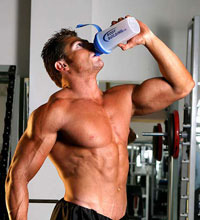
Dear Davey
I just recently began going the gym. I am 6 ft tall and 135 lbs. I’m 18 years old and really have been working hard to see results. I recently started creatine for an extra boost because it was hell trying to lift weights. What are some tips you can give me to gain weight in muscle and get a more cut look?
From,
Joey
Dear Joey,
It sounds like you’re ready to make the transition from twinkville to beeftown.
You’ll want to pay careful attention to your diet. For a week or two, keep tabs on what you typically eat. If you can, count the calories to give yourself a benchmark. Since you want to gain muscle mass - and since you’ve already taken the important step of hitting the gym - don’t be afraid to crank up your intake.
When someone is looking to lose weight, we tell them to create a calorie deficit. That is, they are taking in fewer calories than they are burning. For you, it’s just the opposite. You’ll want to take in more calories than you are burning. It doesn’t need to be dramatic; even a 10% or 20% increase will make a difference. If you find that you are gaining weight too quickly - or it is coming on as fat instead of muscle - you can always scale back.
Having said that, it’s not a free pass to eat cheese puffs, bonbons and make frequent visit to McDonald’s. You’ll still want to eat healthy foods including lean meats, healthy fats (i.e., nuts and avocados), fruits, beans, veggies and the like. You’ll just be eating more of them - and perhaps more frequently - than before.
When it comes to exercise, focus most of your efforts on strength training. While it’s still fine to perform some cardio (definitely no more than 30% of your gym time), acquaint yourself with the free weights. Since you’re looking to build muscle, you’ll opt for a low number of repetitions of very heavy weights - and you’ll target muscle failure. Here are some more muscle-building tips.
And yes, you may find that the creatine will help. Many individuals report significant weight gains in just the first month. Ensure that you are cycling the creatine (i.e., one week of 20 grams followed by one week of 5 grams, and an occasional week off) for best results.
Also, be realistic: As a skinny guy, you probably don’t have the frame to look like a muscle daddy. But embrace and rock what you do have - and know that many of us would give our right testicle to have your metabolism.
Love,
Davey











